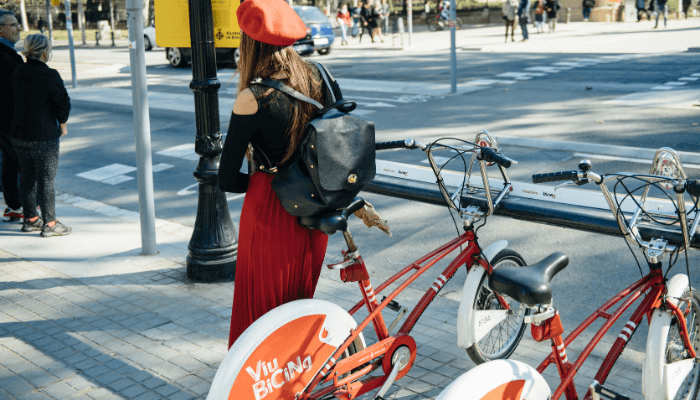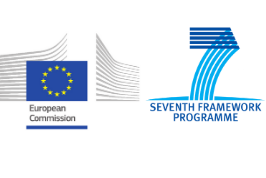- Evolutive User-centric Networks for Intraurban Accessibility
- Consortium: IFISC-CSIC-UIB (project coordinator); Nommon; CASA-UCL; IPhT-CEA; IVT-ETH Zurich; Antonio Lucio Gil; IMI-Ajuntament de Barcelona.
- 2012 – 2014

The project
EUNOIA (Evolutive User-centric Networks for Intraurban Accessibility) is a research project funded under the European Union’s Seventh Framework Programme ICT Programme. The goal of EUNOIA was to take advantage of the opportunities brought by smart city technologies and the most recent advances in complex systems science to develop new urban models and ICT tools empowering city governments and their citizens to design better mobility policies.
EUNOIA was an interdisciplinary project conducted by seven partners that contributed to attain the project’s goals with their expertise in different fields: Institute for Cross-Disciplinary Physics and Complex Systems (IFISC, CSIC-UIB); Nommon Solutions and Technologies; Centre for Advanced Spatial Analysis (CASA, UCL); Institute de Physique Théorique (IPhT, CEA); Institut für Verkeshrsplanung und Transportsysteme (IVT-ETH Zurich); Antonio Lucio Gil; and Institut Municipal d’Informàtica, Ajuntament de Barcelona. The EUNOIA project started in October 2012 and ran for two years.
Read EUNOIA’s position paper.
Context
Urban transport is essential for citizens to perform their daily activities, but at the same time constitutes one of the major sources of GHG emissions and urban pollution (local air quality, noise), directly affecting citizens’ health and well-being. The quest for environmentally sustainable urban transport, while ensuring competitiveness and addressing social concerns, such as health problems or the needs of persons with reduced mobility, is a common and urgent challenge for all major cities in Europe. To tackle the challenge of sustainable urban mobility, urban planners need models, decision support tools, and input data allowing the assessment of policies and their resulting effects. Urban models serve various purposes: first, models help achieve an enhanced understanding of urban dynamics (in an explanatory role); second, they enable virtual experimentation by allowing the prediction of the impact of new infrastructures, technologies, or policies (in a predictive role); finally, models are powerful tools to facilitate participatory processes for collaborative decision making (in a policy design role).
Cities have been treated as systems for several decades, but only recently has the approach changed from aggregate equilibrium systems to complex, evolving systems of systems. Different types of urban models have been developed, from the static and aggregate land use-transportation interaction (LUTI) models, first developed in the 1960s, to recent activity-based microsimulation models which seek to represent cities in more disaggregate and heterogeneous terms. To fully support the assessment of urban mobility policies in terms of a comprehensive set of economic, social, and environmental sustainability indicators, further research is needed along three main axes:
- Data collection. The development and validation of improved models critically relies on the availability of data. Data collection efforts have traditionally been focused on trip data (origin-destination, travel time, mode, etc.), but there is a lack of appropriate data on factors determining mobility behaviour, such as attitudes and lifestyle, which are particularly important, for instance, for developing demand management concepts aiming to influence mobility decisions.
- Theoretical research. On the demand side, many questions are open, such as the activity patterns underlying human travel behaviour, the social acceptance of transport systems and mobility policies, or the relationship between land use and transport demand and how to quantify the contribution of transport infrastructure to land value. As for the transport supply side, particularly interesting are questions about the impact of ICT-based services, new services with the potential to improve urban mobility (e.g., how to make car and bike sharing schemes more appealing), intermodality, or the alternatives to private, fossil fuel-based car, such as electric and hybrid.
- Link between modellers, decision makers, and societal actors. The use of system models in policy making and planning is very heterogeneous. Many cities do not use any quantitative models at all; among the cities using simulation models, traditional 4-stage transport models are still the most applied. The use of more advanced, state-of-the-art models based on complex systems modelling techniques (particularly of agent-based models) is scarce, and in many cases the potential users do not have the skills to use such models or are not convinced of the benefits. To bridge this gap, the development of the models needs to be user-driven and be accompanied by user-model interaction methodologies facilitating a smooth integration of models into decision-making processes.
EUNOIA’s objectives
The objectives of EUNOIA were the following:
- To investigate how new data available in the context of smart cities can be exploited to understand mobility and location patterns in cities.
- To characterise and compare mobility and location patterns in different European cities.
- To improve the understanding of the interdependencies between social networks and travel behaviour.
- To enhance urban transportation models, by integrating the role of the social network and new models of joint trips and joint resource use into state-of-the-art agent-based models.
- To develop useful policy interfaces and appropriate methodological procedures for the use of simulation tools in multi-stakeholder, collaborative assessment of urban transport policies.
- To apply the new models and methodologies to several case studies of interest for policy makers.
Public deliverables
- D7.2 Stakeholder Consultation Report
- D2.1 Methods and Tools for Urban Mobility Policy
- D3.1 Report on Data Collection
- D4.1 Analysis of Mobility Patterns: Interdependence of Mobility with City Structure and Social Networks
- D4.2 Typology of Mobility Patterns
- D5.1 Interface Module
- D5.2 Joint Choice and Joint Use Module
- D5.3 Analysis Module
- D6.1 Report on Case Study 1: London
- D6.2 Report on Case Study 2: Zurich
- D6.3 Report on Case Study 3: Barcelona
- D1.3 Final Publishable Summary Report
Scientific papers
- T. Louail, M. Lenormand, M. Picornell, O. García Cantú, R. Herranz, E. Frias-Martinez, J.J. Ramasco, M. Barthelemy, Uncovering the spatial structure of mobility networks, Nature Communications 6, 6007 (2015).
- M. Lenormand, T. Louail, O.G. Cantú-Ros, M. Picornell, R. Herranz, J. Murillo Arias, M. Barthelemy, M. San Miguel, J.J. Ramasco. Influence of sociodemographic characteristics on human mobility. Available at arXiv: 1411.7895.
- T. Dubernet, K. Axhausen. Implementing a Household Joint Activity-Travel Multi-Agent Simulation Tool: First Results, Transportation (to appear).
- M. Lenormand, A. Tugores, P. Colet, J.J. Ramasco. Tweets on the road. PLoS ONE 9, e105407 (2014).
- M. Lenormand, M. Picornell, O.G. Cantú-Ros, A. Tugores, T. Louail, R. Herranz, M. Barthelemy, E. Frías-Martínez, J.J. Ramasco. Cross-checking different sources of mobility information. PLoS ONE 9, e105184 (2014).
- P. Fleurquin, J.J. Ramasco, V.M. Eguiluz. Characterization of delay propagation in the airport network. Transportation Journal 53, 330 (2014).
- T. Louail, M. Lenormand, O. García Cantú, M. Picornell, R. Herranz, E. Frias-Martinez, J.J. Ramasco, M. Barthelemy, From mobile phone data to the spatial structure of cities, Scientific Reports 4, 5276 (2014).
- P.A. Grabowicz, J.J. Ramasco, B. Gonçalves and V.M. Eguiluz. Entangling mobility and interactions in social media. PLoS ONE 9, e92196 (2014).
- O. O’Brien, J. Cheshire, M. Batty. Mining Bicycle Sharing Data for Generating Insights in Sustainable Transport Systems, Journal of Transport Geography 34, 262–273 (2014).
- J. Fernández-Gracia, J. J. Ramasco, M. San Miguel and V. M. Eguíluz, Is the Voter Model a model for voters?, Physical Review Letters 112, 158701 (2014).
- R. Louf and M. Barthelemy, Modeling the polycentric transition of cities, Physical Review Letters 111, 198702 (2013).
- T. Dubernet, K. Axhausen. Including joint decision mechanisms in a multiagent transport simulation. Transportation Letters: the International Journal of Transportation Research 5, 175-183 (2013).
- A.P. Masucci, J. Serras, A. Johansson, M. Batty. Gravity versus Radiation Models: On the Importance of Scale and Heterogeneity in Commuting Flows. Physical Review E 88, 022812 (2013).
- M. Batty, C. Vargas, D. Smith, J. Serras, J. Reades, A. Johansson. SIMULACRA: fast land-use–transportation models for the rapid assessment of urban futures. Environment and Planning B: Planning and Design 40, 987 – 1002 (2013).
- A. Tugores and P. Colet, Big data and urban mobility, Proceedings of the 7th Iberian Grid infrastructure conference, October, 2013.
- M. Barthelemy, P. Bordin, H Berestycki and M. Gribaudi, Self-organization versus top-down planning in the evolution of a city, Scientific Reports 3, 2153 (2013).
- T. Dubernet and K. Axhausen, Including joint decision mechanisms in a multiagent transport simulation, Transportation Letters: the International Journal of Transportation Research 5, 175 (2013).
Resources
Transport model for London using MATSim (private vehicles)
This animation shows the estimated vehicular movements during a typical working day in London. This has been obtained from an activity-based transport model developed at CASA in University College London, under the EUNOIA research project. The MATSim software has been used to run the traffic assignment. The authors involved in the building of the model are Joan Serras, Melanie Bosredon, Vassilis Zachariadis, Camilo Vargas-Ruiz, Thibaut Dubernet and Mike Batty. We acknowledge TfL for the provision of key data sources to the model and Senozon for the Via software to visualise the outputs.
Transport model for London using MATSim (activities)
This animation conducted under the EUNOIA research project shows the distribution of activities performed by synthetic individuals throughout a typical working day in London. This is achieved by plotting each person in the model performing a certain activity in its corresponding colour (home: dark blue; work: light blue; shop: yellow; education: green; leisure: pink).
EUNOIA visualiser tool
The EUNOIA visualiser tool allows the study of different geo-referenced information. In this web, it is applied to supply and demand in bike-sharing stations.

EUNOIA is a research project funded under the European Union’s Seventh Framework Programme (FP7).
